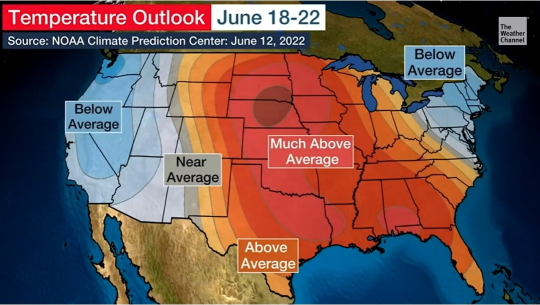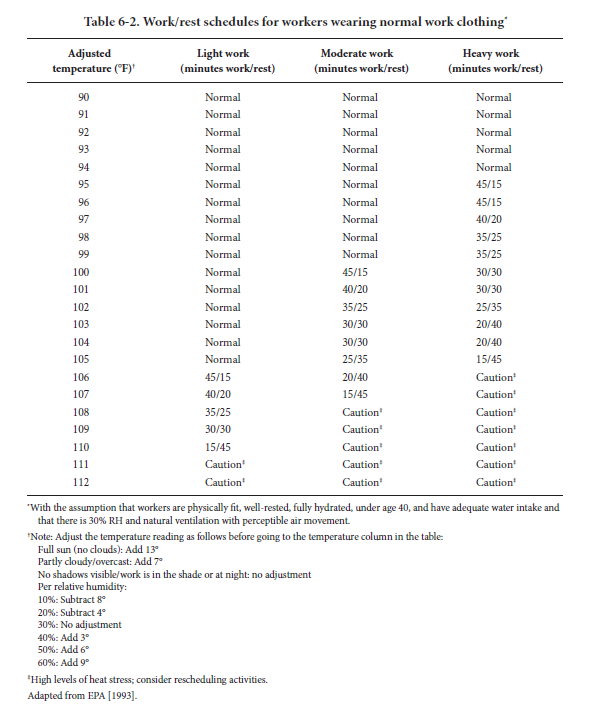Wisconsin temperatures can reach the high 80’s or 90’s in July and August, but to reach these temperatures in June is above normal. When the temperature rises so does the danger of heat exhaustion. The combination of heat, humidity and physical labor brings special hazards for those exposed to these conditions. Elevated body temperatures can cause problems as simple as physical discomfort or as serious heat stroke which can cause death. For anyone who must work outdoors or indoors where there is little or no air conditioning, a wave of extreme heat can turn the workplace into a dangerous environment.

The best defense is prevention. Here are some prevention tips:
If a Heat Wave Is Predicted or Happening… Slow down. Avoid strenuous activity. If you must do strenuous activity, do it during the coolest part of the day, which is usually in the morning between 4:00 a.m. and 7:00 a.m.
- Stay indoors as much as possible. If air conditioning is not available, stay on the lowest floor, out of the sunshine. Remember, electric fans do not cool the air, but they do help sweat evaporate, which cools your body.
- Water is the safest liquid to drink during heat emergencies. Avoid drinks with alcohol or caffeine in them. They can make you feel good briefly, but make the heat’s effects on your body worse. This is especially true about beer, which dehydrates the body.
- Wear lightweight, light-colored, loose-fitting clothing.
- NEVER leave anyone in a closed, parked vehicle.
Although any one at any time can suffer from heat-related illness, some people are at greater risk than others. Check regularly on:
- Infants and young children – require more frequent watching
- People aged 65 or older – visit at least twice a day
- People who have a mental illness
- Those who are physically ill, especially with heart disease or high blood pressure
If you must be out in the heat:
- Limit your outdoor activity to morning and evening hours.
- Try to rest often in shady areas.
- Protect yourself from the sun by wearing a wide-brimmed hat (also keeps you cooler) and sunglasses

Combine the current Relative Humidity (%) and Temperature (˚F)
Examples of each Category using 75% Relative Humidity from the National Weather Service Heat Index Chart
Caution: 75% Relative Humidity and 80 ˚F Temperature = 84 ˚F Heat Index
Extreme Caution: 75% Relative Humidity and 84 ˚F Temperature = 92 ˚F Heat Index
Danger: 75% Relative Humidity and 90 ˚F Temperature = 109 ˚F Heat Index
Extreme Danger: 75% Relative Humidity and 96 ˚F Temperature = 132 ˚F Heat Index

Example of a Heat Advisory for June 14, 2022.


Important Terms to Understand
Heat wave: Prolonged period of excessive heat and humidity. The National Weather Service steps up its procedures to alert the public during these periods of excessive heat and humidity.
Heat index: A number in degrees Fahrenheit (F) that tells how hot it really feels when relative humidity is added to the actual air temperature. Exposure to full sunshine can increase the heat index by 15 degrees F.
HEAT EXHAUSTION – Feeling weak or dizzy? Dizziness, weakness, nausea, vomiting, profuse sweating, extreme thirst and headaches are all symptoms of heat exhaustion. Over‑exposure to heat or over‑exertion in high temperatures causes it and immediate attention is crucial.
Treatment: Get the person out of the heat and into a cooler place. Remove or loosen tight clothing and apply cool, wet cloths, such as towels or sheets. If the person is conscious, give cool water to drink. Make sure the person drinks slowly. Give a half glass of cool water every 15 minutes. Do not give liquids that contain alcohol or caffeine in them, as they can make conditions worse. Let the victim rest in a comfortable position with their feet elevated slightly, and watch carefully for changes in his or her condition. Heat exhaustion is a more serious reaction than heat stress and recuperation can take longer. Heat exhaustion victims should be treated immediately, it is usually not life threatening.
HEAT STROKE – By far the most serious heat‑related condition, heat stroke CAN kill. The importance of avoiding the level of exposure to heat that can lead to heatstroke cannot be overemphasized. Heat stroke is marked by cessation of sweating and extremely high body temperature as high as 105 degrees F. Victims are often disoriented and confused. Their skin may be hot to the touch. Effects of heat stroke also include nausea, vomiting, seizures and shortness of breath. Collapse is not uncommon and death is distinctly possible.
Treatment: Help is needed fast. Call 9-1-1, heat stroke is a life-threatening situation. Contacting emergency medical personnel as soon as possible. Move the person to a cooler place. Quickly cool the body. Immerse victim in a cool bath, or wrap wet sheets around the body and fan it. Watch for signals of breathing problems. Keep the person lying down and continue to cool the body any way you can. If the victim refuses water or is vomiting or there are changes in the level of consciousness, do not give anything to eat or drink.
A 30-year-old male landscape mowing assistant collapsed and died of heat stroke after a day of caring for residential lawns [NIOSH 2002]. Two hours before his death he had complained of feeling light-headed and short of breath, but he refused assistance offered to him by his partner. The worker was on medication that had a warning about exposure to extreme heat, and this might have interfered with body temperature regulation. The landscape worker had been wearing two pairs of work pants on the day he died, but his partner did not notice any profuse sweating or flushed or extremely dry skin. Upon collapse, the victim was treated by emergency medical services (EMS) personnel at the site and then transported to the hospital. There he was pronounced dead, with an internal temperature of 107.6°F. On the day of the incident, the maximum air temperature was 81°F.
The following recommendations were made after the incident:
Employers should ensure that supervisors/managers monitor workers during periods of high heat stress. Identify workers with risk factors that would predispose them to heat-related illnesses. Train Workers about heat stress, heat strain, and heat-related illnesses. Stress the importance of drinking non-alcoholic beverages before, during, and after working in hot conditions. Periodically remind workers of the signs of heat-related illnesses and encourage them to drink plenty of water during hot conditions.
Construction Case Study
A 41-year-old male construction laborer was sawing boards to make concrete forms that were to be part of an addition to a factory [NIOSH 2004]. At 5 p.m. the worker collapsed in the parking lot on the way to his vehicle. He was found 30 minutes later by a factory worker, who then returned to the factory and reported the situation to a supervisor. The receptionist was instructed to call EMS while the supervisor administered emergency care to the collapsed worker. The worker’s body temperature was recorded as 107°F by the EMS and as 108°F when admitted to the hospital. The worker died the next day from heat stroke.
The following recommendations were made after the incident:
Train supervisors and workers to recognize symptoms of heat exhaustion/stroke when working in high heat index and/or humid conditions. To avoid dehydration and exhaustion/stroke, workers should be given frequent breaks and be provided drinking water and other hydrating drinks when working in humid or hot conditions. Work hours should be adjusted to accommodate environmental work conditions such as a high heat index and/or high humidity.

Sources: Red Cross, National Weather Service
